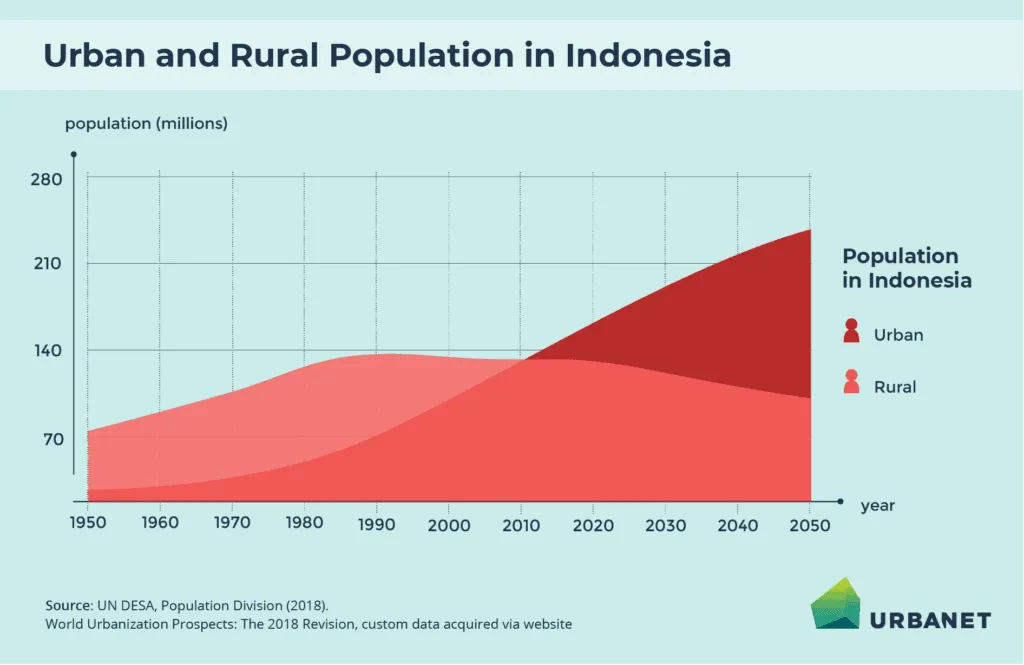Urbanization in Indonesia is accelerating at an unprecedented pace. As of 2023, 58.57% of the population lives in urban areas, up from 51% in 2010. This shift underscores the increasing importance of cities as economic and social hubs. With urbanization projected to reach 59.6% by 2025, demand for housing, commercial spaces, and infrastructure is surging. Join us as we explore Indonesia Urbanization Trends below!
Indonesia Urbanization Trends: Residential Demand on the Rise

Indonesia’s urban population reached approximately 164.7 million in 2023. This growth has created a massive need for residential projects. Experts estimate that 13 million new housing units will be required by 2025 to accommodate this expanding urban population.
Read Also: The Struggle of Indonesia Affordable Housing Challenges
Meeting this demand is not just about numbers. Developers are increasingly focusing on affordable and sustainable housing solutions to address both population growth and environmental concerns. This shift represents an opportunity for innovative construction practices to flourish.
Commercial Development Gains Momentum
The rise in urbanization is also driving demand for commercial real estate. The sector is expected to grow by nearly 15% annually as urban centers become hubs for business and retail activities.
Indonesia’s growing middle class and increasing consumer spending are major factors contributing to this demand. Urban areas are transforming into vibrant commercial zones, with malls, office spaces, and mixed-use developments becoming integral to cityscapes.
Infrastructure: A Critical Need in Indonesia Urbanization Trends
Rapid urban expansion has highlighted the urgent need for infrastructure development. Indonesia requires approximately $60 billion annually to keep pace with urban growth. This includes investments in transportation systems, water supply networks, and energy grids.
Infrastructure not only supports urban life but also drives economic growth by creating jobs and improving connectivity. For example, the construction sector is expected to generate over 1 million jobs annually, emphasizing its role as a vital economic engine.
Read Also: Infrastructure Development Plans Indonesia: The New Era
Read Also: Opportunities in Indonesia Urbanization and Construction Growth
Economic Impact of Urbanization
Urbanization has been a significant contributor to Indonesia’s economic progress. Over the past two decades, poverty rates have decreased by nearly 50%, correlating with increased economic activity in urban areas.
The construction industry has been a primary beneficiary of this trend. Investments in residential, commercial, and infrastructure projects are projected to reach approximately $400 billion by 2025. This growth not only boosts the economy but also addresses critical societal needs like housing and job creation.
Challenges and Opportunities for Indonesia Urbanization Trends
While urbanization brings growth, it also presents challenges. Cities face issues like overcrowding, inadequate infrastructure, and environmental degradation. Addressing these challenges requires sustainable urban planning and smart investments.
Opportunities abound for developers and investors willing to innovate. By focusing on sustainability and efficiency, the construction industry can play a pivotal role in shaping Indonesia’s urban future.
Building a Better Urban Future
Indonesia urbanization trends are reshaping the nation’s construction landscape. From residential projects to commercial hubs and critical infrastructure, the demand is vast and growing. By embracing innovation and sustainability, Indonesia can ensure that its urban expansion benefits both its people and the environment. With the right investments and policies, the nation is poised to transform its cities into engines of growth and prosperity.







